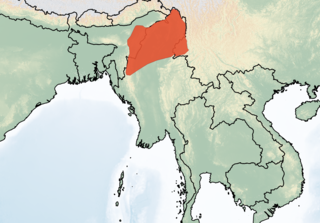
The oncilla, also known as the northern tiger cat, little spotted cat, and tigrillo, is a small spotted cat ranging from Central America to central Brazil. It is listed as Vulnerable on the IUCN Red List, and the population is threatened by deforestation and conversion of habitat to agricultural land.

The northern collared lemming or Nearctic collared lemming, sometimes called the Peary Land collared lemming in Canada, is a small lemming found in Arctic North America and Wrangel Island. At one time, it was considered to be a subspecies of the Arctic lemming. Some sources believe several other species of collared lemmings found in North America are actually subspecies of D. groenlandicus.

Water voles are large voles in the genus Arvicola. They are found in both aquatic and dry habitat through Europe and much of northern Asia. A water vole found in Western North America was historically considered a member of this genus, but has been shown to be more closely related to members of the genus Microtus. Head and body lengths are 12–22 cm, tail lengths are 6.5–12.5 cm, and their weights are 70–250 g. The animals may exhibit indeterminate growth. They are thick-furred and have hairy fringes on their feet that improve their swimming ability.

The big red bat is a species of vesper bat from South and Central America.
The Caucasus field mouse is a species of rodent in the family Muridae.

The Manipur white-toothed rat is a species of rodent in the family Muridae.

The blazed Luzon shrew rat is a species of rodent in the family Muridae, endemic to the Philippines.

The Northern Sulawesi echiothrix or Sulawesi spiny rat is a species of rodent in the family Muridae. It is endemic to northeastern Sulawesi, Indonesia.
The northern groove-toothed shrew mouse is a species of rodent in the family Muridae found in West Papua, Indonesia and Papua New Guinea.

The Brahma white-bellied rat is a species of rodent in the family Muridae. It is found in northeastern India, northern Myanmar, and southwestern China (Yunnan). It lives in various forest habitats at elevations of 2,000–2,800 m (6,600–9,200 ft) above sea level.

The eastern chestnut mouse is a species of rodent in the family Muridae. It is found only in Australia, along the eastern coast from northern Queensland and into New South Wales as far as Jervis Bay.
The dusky rat is an indigenous species of rodent in the family Muridae found in Australia.
The opossum rat is a species of rodent in the family Muridae. It is found only in northern and central Sulawesi, Indonesia.
The dusky field rat, also known as the canefield rat, is a species of rodent in the family Muridae. It is found in Australia, Indonesia, and Papua New Guinea. In Australia it is found in northern Queensland and along the east coast as far south as Shoalwater Bay, where it is plentiful, and on South West Island in the Sir Edward Pellew Group off the Northern Territory, where it is considered a threatened species.
The Andaman rat is a species of rodent in the family Muridae. It is endemic to the Andaman Islands, where it has been recorded on Henry Lawrence Island, South Andaman, and Middle Andaman. It is a nocturnal species that lives in tropical evergreen forests from sea level to 200 m (660 ft) above sea level.
The Carpentarian rock rat is a species of rodent in the family Muridae. It is found only in Australia.

The grey-chinned hermit is a species of hummingbird in the family Trochilidae. It is found in Brazil, Colombia, Ecuador, Peru, and Venezuela.

The montane water vole is a species of vole found throughout Europe, from the mountains of northern Spain through central Europe and eastwards through to central Romania. Initially regarded as a species, it was reassigned as a subspecies of terrestris before being again designated as a species by Panteleyev in 2000. The American Society of Mammalogists treats it as a synonym of Arvicola amphibius.












